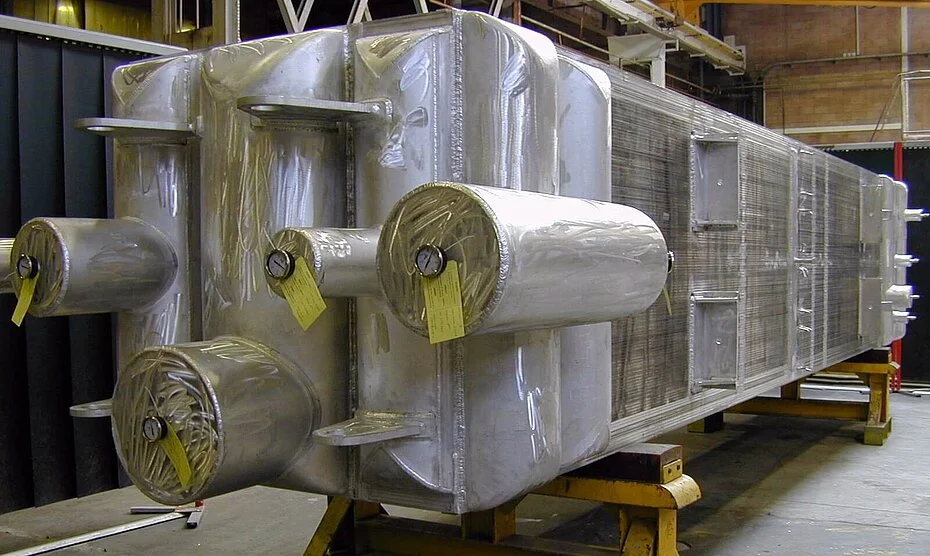Faced with the challenges of the energy transition, hydrogen is presented as a promising solution to replace fossil fuels. However, its very nature generates some major technical constraints. Very light in its gas form, hydrogen at atmospheric density occupies a colossal amount of space. To be usable, it has to be either compressed or cooled down until it liquefies. Storing hydrogen gas presents risks (inflammability) and requires high-pressure tanks that are very costly, while liquefaction drastically reduces its volume without impacting its high energy capacity.
However, storing liquid hydrogen comes with its own difficulties; the gas has to be cooled to extremely low temperatures – below -253°C – to transform it to a liquid state and maintain it in this form. This complex process is at the core of the HyGen project, conducted since 2023 by Ademe and led by the Fives group, which manufactures cryogenic heat exchangers. Supported by a €3.4 million budget allocation, this program forming part of the France 2030 plan focuses on the design of super-tanks for heavy mobility: cold boxes that are capable, with the help of a heat transfer fluid, of reaching the low temperatures required for storing liquid hydrogen.
For this, the project has called upon two researchers from Mines Saint-Étienne, Éric Serris and Sylvain Martinont. They each contribute their respective expertise, in powder technology and digital simulation of granular environments, in an attempt to remove a very specific technical obstacle: grain pile-up in the heat exchanger plates.
Against the grain
The functioning principle of a heat exchanger is simple yet sophisticated: heat is transferred between two fluids (sometimes more) circulating separately and at different temperatures. The walls of the HyGen exchangers are made of seven-meter-high aluminum plates separated by a space of a few millimeters in which a heat transfer fluid circulates. The plates act as heat conveyors, facilitating the transfer of heat between the cold and hot fluids to achieve by the end of the process the cryogenic conditions required to liquefy hydrogen.
The space in which the fluid circulates between the plates also contains a dense layer of catalytic grain. This is intended to speed up the conversion of the hydrogen from an unstable form of its liquid state, called ‘ortho’, to a stable form known as ‘para’. In addition, as the fluid circulates around the grain – without causing it to move – this also has the effect of accelerating the transfer of heat necessary to maintain heat exchanges with the exchanger walls.
Flow uniformity is crucial to maintain high energy performance and at the same time avoid heat loss. However, to distribute catalytic grain homogeneously across such narrow, vertical spaces is a real scientific challenge. “The way the space is filled must be optimal in order to ensure maximum catalyst density with no channeling”, explains Sylvain Martin.
Complexity of granular environments: neither fluid nor solid
To solve this scientific question worthy of a school math problem, the two researchers have built exchanger models that they attempt to fill. Granular environments have specific characteristics that vary with the observation scale. “At large scale, they behave like fluids and the principles of fluid mechanics apply. But at the scale of the grain, friction and contact prevail and a different approach is required”, Sylvain Martin develops.
The quality of the flow and the rearrangement of the grain therefore depends on the nature of the material and its surface. However, the two experimenters cannot study the end material directly as it is “very rare and very expensive”, states Éric Serris. “So we used model materials whose geometric and mechanical properties resemble those of the target material, close to those of railroad ballast.” The model grain, made up of small, regular polyhedra, thus provide a practical solution for understanding how they behave.
Back and forth between simulations and experiments
The two researchers from Saint-Étienne also combine their physical experiments with digital simulations. “The difficulty of manipulation lies in the measurement of all the data and having access to it. In simulation, we can measure all the interactions – strengths, positions – of each grain and at each moment”, Sylvain Martin explains. “Digital simulations give us a precise understanding of phenomena that are difficult to study in a laboratory, and a powerful means of formulating a hypothesis and validating it under controlled conditions.”
These models must, however, be carefully calibrated. “The model is an imperfect representation of reality. Therefore, to validate it, we have to switch back and forth between simulations and experiments”, he adds. Researchers are therefore testing various scenarios, as physical experiments sometimes allow us to confirm the trends observed with the model and to note its limitations and the necessary adjustments.
“An all-French initiative” for decarbonization
This joint approach should enable the duo to provide Fives with precise recommendations for filling exchanger plates, as well as the geometric and morphological characteristics of grains, details which are essential to enhance exchanger performance. “In concrete terms, we deliver detailed recipes, but top chefs keep their secrets”, declares Éric Serris with a smile.
For many years, the industrial group’s research teams have been working on the development of increasingly advanced equipment for strategic hydrogen-related uses. The HyGen project, for example, is specifically addressing the needs of decarbonized heavy mobility (long-distance heavy trucks, container ships, aircraft, etc.).
To further develop this initiative, the manufacturer relies on an ecosystem of local stakeholders: several SMEs in the Auvergne-Rhône-Alpes region, including the design offices CFD-Numerics and EC2 Modélisation, who specialize in mechanical simulation and modeling, and CEA Grenoble for cryogenic testing. For another aspect of the project, it also counts on the cooperation of the Saclay and Cadarache branches of CEA, who carry out tests on thermomechanical fatigue. “This is an all-French initiative that puts local talent to good use while addressing the global issue of energy transition”, concludes Éric Serris.





